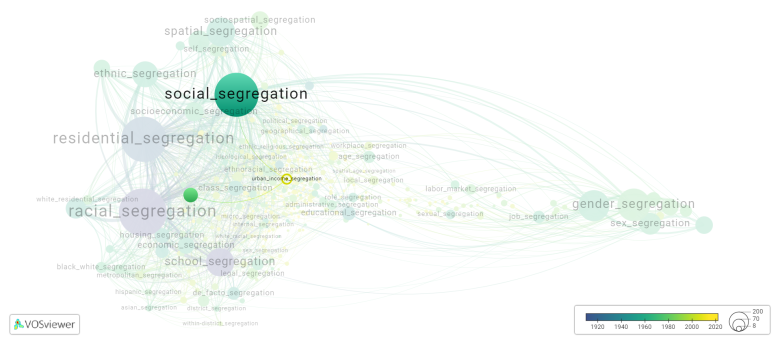Urban income segregation: Difference between revisions
(Creating page) |
(Creating page) |
||
| Line 22: | Line 22: | ||
[[File:urban_income_segregation.png|780x780px]] | [[File:urban_income_segregation.png|780x780px]] | ||
Visualization based on the [[How_to_cite_Segregation_Wiki| research]] | |||
For the complete network of associated segregation forms, see: | For the complete network of associated segregation forms, see: | ||
year of publication https://tinyurl.com/2235lkhw | * First year of publication https://tinyurl.com/2235lkhw | ||
Louvain clusters https://tinyurl.com/2d8wg5n3 | * Louvain clusters https://tinyurl.com/2d8wg5n3 | ||
* Betweenness centrality https://tinyurl.com/223udk5r | |||
* Disciplines where segregation forms first appeared https://tinyurl.com/244d8unz | |||
==References== | ==References== | ||
==Notes== | ==Notes== | ||
Revision as of 13:41, 3 October 2024
Date and country of first publication[1]
2016
United States
Definition
Urban income segregation refers to the division and clustering of different income groups within a city. It occurs when people of similar incomes tend to live in close proximity to one another, resulting in neighborhoods or districts of the city that predominantly consist of individuals from one income bracket.
There are several factors that contribute to urban income segregation. One key factor is housing affordability and availability. In many cities, housing prices vary significantly across different neighborhoods, which can create barriers for lower-income individuals and concentrate them in certain areas. Additionally, the availability of amenities and services, such as quality schools, public transportation, and recreational facilities, can also influence income segregation as higher-income individuals may seek out neighborhoods that offer these amenities.
Urban income segregation can have various consequences for both individuals and cities as a whole. One of the main concerns is the perpetuation of poverty and inequality. Concentrating low-income individuals in specific neighborhoods often limits their access to resources and opportunities, such as good education, healthcare, and employment prospects, which can hinder their social and economic mobility.
Furthermore, income segregation can contribute to social isolation and divide communities along socioeconomic lines. It can create a lack of diversity and limit social interaction between individuals from different income groups, leading to reduced understanding and empathy among residents.
From a city planning perspective, urban income segregation presents challenges in terms of providing equitable services and ensuring access to amenities for all residents. Addressing income segregation requires comprehensive urban policies that focus on affordable housing, equitable educational opportunities, and improved access to essential services throughout the city.
Overall, urban income segregation is a complex and multifaceted issue that requires attention and intervention to promote a more inclusive and equitable urban environment.
See also
Related segregation forms
Urban income segregation is frequently discussed in the literature with the following segregation forms:
social segregation, income segregation, poverty segregation

Visualization based on the research
For the complete network of associated segregation forms, see:
- First year of publication https://tinyurl.com/2235lkhw
- Louvain clusters https://tinyurl.com/2d8wg5n3
- Betweenness centrality https://tinyurl.com/223udk5r
- Disciplines where segregation forms first appeared https://tinyurl.com/244d8unz
References
Notes
- ↑ Date and country of first publication as informed by the Scopus database (December 2023).
At its current state, this definition has been generated by a Large Language Model (LLM) so far without review by an independent researcher or a member of the curating team of segregation experts that keep the Segregation Wiki online. While we strive for accuracy, we cannot guarantee its reliability, completeness and timeliness. Please use this content with caution and verify information as needed. Also, feel free to improve on the definition as you see fit, including the use of references and other informational resources. We value your input in enhancing the quality and accuracy of the definitions of segregation forms collectively offered in the Segregation Wiki ©.
Urban income segregation appears in the following literature
Lens M.C., Monkkonen P. (2016). Do Strict Land Use Regulations Make Metropolitan Areas More Segregated by Income?. Journal of the American Planning Association, 82(1), 6-21. Routledge.https://doi.org/10.1080/01944363.2015.1111163
Santos M.I.D., Santos G.F.D., Freitas A., Sousa Filho J.F.D., Castro C., Paiva A.S.S., Friche A.A.D.L., Barber S., Caiaffa W.T., Barreto M.L. (2021). Urban income segregation and homicides: An analysis using Brazilian cities selected by the Salurbal project. SSM - Population Health, 14(), -. Elsevier Ltd.https://doi.org/10.1016/j.ssmph.2021.100819
